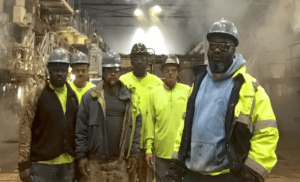

Champion employees face hazardous conditions they need to avoid or remove to perform their tasks safely during the winter months. Slips, trips, and falls, require increased focus during these months. Snow, Ice, mud, and inclement weather compound the likelihood that you may encounter these hazard types more frequently during January, February, and March.
Exposure to the elements of winter can range from discomfort to a potentially dangerous situation that can result in severe injury or even death. A couple of the more common yet potentially dangerous conditions you may encounter in winter months are Frostbite and Hypothermia.
Frostbite is caused by severe cold, usually to your toes, fingers, ears, or nose, which can cause permanent loss of tissue.
Symptoms of frostbite may include:
Very severe frostbite may cause:
Prevention – Be aware of factors that can contribute to frostbite. These include extreme:
Poor blood circulation. Poor circulation can be caused by tight clothing or boots, cramped positions, fatigue, certain medicines, smoking, alcohol use, or diseases that affect the blood vessels, such as diabetes.
Wear clothing that protects you well against the cold. Protect exposed areas. Wear wintry weather gloves and wind-proof, water-resistant, layered clothing; two pairs of socks; and a hat or hardhat liner that covers the ears (to avoid heat loss through the scalp).
If you expect to be exposed to the cold for a prolonged period, do not drink alcohol or smoke. Make sure to get enough food and rest.
Hypothermia. When the body is exposed to cold temperatures, it becomes hard for it to self-regulate warmth. It begins to lose heat faster than it can be produced. Prolonged exposure to cold can cause the internal body temperature to drop, which can lead to a condition called hypothermia. Hypothermia can impact brain function, which is especially dangerous as a person may not be able to recognize the symptoms until it is too late.
If a worker is suffering from the effects of hypothermia, immediately call emergency medical services. Remove any wet clothing and cover the body with loose, dry blankets, clothing, or towels. Provide warm, non-alcoholic, and non-caffinated beverages if the worker is conscious and if the worker should lose a pulse, CPR should be administered.
While slips, trips and falls can be a major hazard at any time of year, they appear almost daily as you encounter slick conditions of ice and snow. Slips, trips, and falls can lead to bruises, abrasions, broken limbs, cracked ribs, serious back injuries and even trauma to the head. These hazards should be anticipated, and steps taken to prevent these types of injury on our projects.
Champion employees are to anticipate these hazards and assess working areas for slick spots that can result from ice or snow. Be sure to check areas where you enter and leave indoor areas for slick spots and ice buildup. All employees should regularly look for and report to your supervisor all conditions that could lead to slip, trip, and fall hazards.
In the end, preparing for wintery weather and extreme cold will help any employer in any industry ward off cold-related hazards on the jobsite, ensure that team members know and understand how the cold can impact their bodies
Champion is currently executing the Paper Machine Ceiling Structural Replacements project for Georgia-Pacific in their facility in Cedar Springs, GA. This project consists of building and utilizing a mobile platform on top of the facility’s “Wet End” Crane. The mobile platform consists of 24’ aluminum I-beams, plywood, and flame retardant, reinforced Visqueen.
The platform is used to gain access to the roof system’s bottom chords for the replacement of cross members, gusset plates, and column cladding. It is also utilized to install the enclosure above bottom chords and for blasting and painting operations. The base scope of this project has grown as Champion has worked with an onsite engineer to identify additional steel that has deteriorated beyond repair. This includes removing and replacing all sag rods, repairing HVAC ductwork, and other items.
Champion’s crew consists of 6-7 safe and hard-working painters and laborers operating in extreme environmental conditions – which are consistently above 120 degrees over the paper machine. The project also includes a subcontract with UWI out of Sanford, FL for steel replacement. Project Superintendent Ronnie West has done an excellent job managing all aspects of the engagement. The project started in July 2023 and will be completed in May of 2024, consisting of approximately 4500+ hours without accident or incident.
Great Job to our GP Cedar Springs Champions!

Supervisor: Ronnie West
Crew: Jeff Zachary, James Brown, Timothy Kates, Tomor Salmon, Judah Salmon, Kevin Knight
Contact Champion